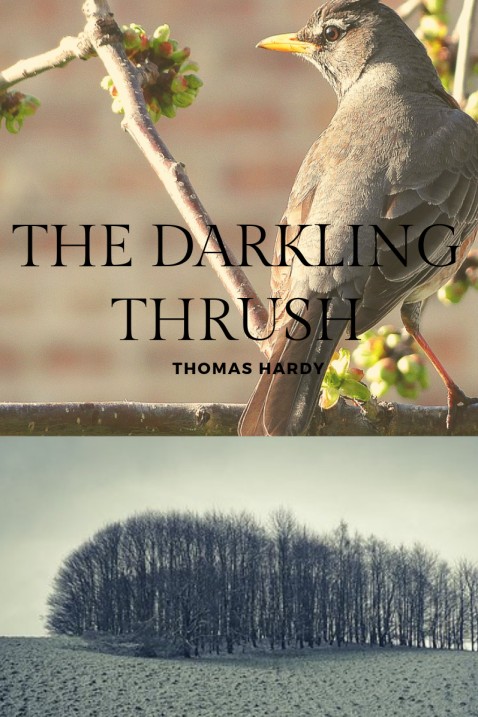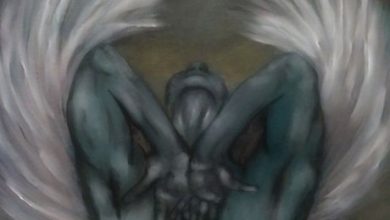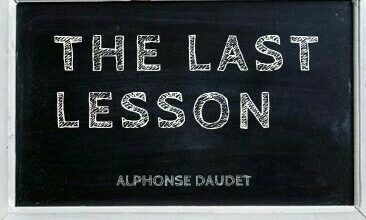
The Darkling Thrush : The Poem
The Darkling Thrush is a fine example of a poem which engages with a recurrent theme present across a bulk of Victorian Literature and visible throughout Hardy’s oeuvre: the interplay between Hope and Despair. The element of Nature is masterfully handled in this poem to bring out the contrasting forces of Hope and Despair and its significance to humanity. Composed in four rhymed stanzas of ababcdcd rhyme scheme, the poem also captures a moment of transition whether it pertains to the that of the Victorian Age or the personal life of the poet himself.
Got No Time? Check out this Quick Revision by Litbug. Click on the link below.
The Darkling Thrush | Summary and Analysis
The poet persona finds himself leaning against a wooden gate in a sombre mood, perfectly complemented by the harsh wintry weather. The landscape, the bare trees, the cold wind and everything around him seem to have come under the spell of a dreary desolate winter. Piercing through this lifeless state comes a voice from the “bleak twigs overhead” : An aged thrush, no better off than his surroundings – “frail, gaunt and small” sings a joyful song under such a gloomy condition. The poet sees no immediate cause that could trigger such fervour in the bird. He can’t help but think there might be some great mysterious hope of which the little bird understands and he did doesn’t.
Originally titled “The Century’s End“, Hardy composed the poem towards the end of the 19th Century when he was in his late sixties. He had given up writing novels and switched to poetry, partly owing to the harsh criticism of his novels Jude the Obscure and Tess of the D’ubervelles. He had seen the rapid industrialization of England and the slow decline of his beloved countryside. He had witnessed the “glory” of the Empire and had intensely hated its colonial mindset and its involvement in the Boers War. Also, his Christian faith was accosted with the theories of Darwin and Mill, as a result of which the idea of an afterlife turned a blurry fiction at a time when his aged self was rapidly advancing towards the inevitable. Naturally, he was apprehensive of all that was to come and the cloud of uncertainty hung heavy on his mind. And he was not alone. Victorian society, whose precepts and suppositions had been challenged by new findings in natural sciences could no longer blindly rely on the tenets of religion and had become engulfed in an age of uncertainty.With this context in mind, The Darkling Thrush becomes a significant poem which doesn’t merely project the perception and feelings of one person but is representative of the mood of an age.
The Darkling Thrush | Analysis , Stanza 1
I leant upon a coppice gate
When Frost was spectre-grey
And Winter’s dregs made desolate
The weakening eye of day.
The tangled bine-stems scored the sky
Like strings of broken lyres,
And all mankind that haunted nigh
Had sought their household fires.
As is evident, each stanza of the poem is composed of eight lines with ababcdcd rhyme scheme. The lines of each stanza follows a recurrent pattern on an iambic tetrameter followed by an iambic trimeter as shown below :
I leant upon a coppice gate
When Frost was spectre-grey
And Winter’s dregs made desolate
The weakening eye of day.
The poem begins with the poet-persona leaning upon a coppice (wooden) gate on a wintry day. Everything seems to have a desolate and gloomy look about it, thanks to the chilling effects of the winter which is given a ghost-like resemblance (spectre-grey). A brilliant metaphor of the feeble sun ( weakening eye of day) and a simile of the leafless trees which wound the sky in a claw-like manner (the tangled-bine stems scored the sky
Like strings of broken lyres) is used to describe the dull desolation brought about by the winter. The deathly silence of the setting is heightened by the simile “like strings of broken lyre“. The bine stems pierce the sky like the string of a broken musical instrument which can no longer make any music and has been rendered silent by the death-like winter. The lyre (a harp-like stringed instrument) was the instrument of the Muses, the goddesses of Poetry in Greek Mythology. The imagery of a broken lyre is symbolic not only of complete silence but also complete ceasing of creative activity. No human being is in sight as people are warming themselves in their respective homes. The use of “all mankind” suggests a universal refusal to engage with the wintry surroundings. The only person who is standing outside is the poet who is watching the “The Century’s corpse outleant”.
The Darkling Thrush | Analysis, Stanza 2
The land’s sharp features seemed to be
The Century’s corpse outleant
His crypt the cloudy canopy,
The wind it’s death lament.
The ancient pulse of germ and birth
Was shrunken hard and dry
And every spirit upon earth
Seemed fervourless as I.
The speaker stands alone in the wintry evening , contemplating on the desolate landscape of the century that was. It is the end of the day, the end of the year and the end of the century.
The imagery of desolation and despair is extended further into the second stanzas wherein the theme of death is made explicit and is given a much greater magnitude to encompass time and space. Because the poem was composed around the end of the 19th century, the phrase “The Century’s corpse outleant” is brilliantly employed to highlight the end of an age.
The alliteration “his crypt the cloudy canopy” heightens the gloomy atmosphere of the setting and the brooding mood of the poem . The use of “crypt” to refer to the cloudy sky links the “Century’s corpse ” of the preceding line to the “death lament” of the wind in the succeeding one, thus completing the sights and sounds of a funeral. The seed, which has been representative of life since time immemorial has shrivelled up and has become hard and dry , symbolizing the defeat of the ancient signifier of life to the deathly winter.
Elements of weather, the cloudy sky, the death-lament of the wind and life itself have been overpowered by this deathly winter. Notice the increasing magnitude of elements which have come under the grasp of this dreary winter –from the tangled bine-stems , to men seeking warmth, to the corpse-like landscape, the sky , the wind , the dry seed of life and eventually, “every spirit upon earth ” : all seem helpless in front of the hopeless winter. This makes the birdsong of the thrush in the third stanza all the more powerful and lends a much greater significance to the hopeful challenge this tiny bird poses against the mighty winter.
The Darkling Thrush | Analysis, Stanza 3
At once a voice arose among
The bleak twigs overhead
In a full-hearted evensong
Of joy illimited ;
An aged thrush, frail, gaunt and small,
In blast-beruffled plume,
Had chosen thus to fling his soul
Upon the growing gloom
Hardy makes a great use of the element of surprise by beginning the third stanza with a sudden “At once..”. This sharply contrasts with the first two stanzas of dull inaction and effectively ushers the third and fourth stanzas, both replete with hope and life.
The first line of the stanza mimics the birdsong of a thrush through the use of assonance (At once a voice arose among ) and sibilance (Had chosen thus to fling his soul ) .
Furthermore, what is remarkable about the third stanza is that it solicits the reader’s attention to both the song and it’s singer. The little bird is in no better shape than his surroundings. It isn’t a young, stout, beautiful bird that is singing such a joyous song. Rather, we are told that it is an aged thrush, “frail, gaunt and small”, with a “blast-beruffled” plume. In short, this is a bird which is old and weak, has possibly not eaten for days (thanks to the winter) and his feathers have received the full blow of the winter wind (which has been likened to a death song in the second stanza). The fact that this pitiable soul chooses to sing his optimistic song despite the adverse situation is what makes his birdsong all the more impactful. When all hope seems lost , and when death immobilizes all, it is the tiny, imperfect little bird which sings a song of hope which becomes a testament of life.
The word “blast-beruffled” used in this stanza is a word invented by Hardy. The poet frequently came up with new words meant be used for a single occasion in order to suit his literary needs. Some such use, also known as nonce words words can be seen throughout the poem which include “darkling”, “spectre-grey”, “outleant” etc. “Darkling” was popular one among Victorian poets and its use can also be seen in Matthew Arnold’s Dover Beach.
The Darkling Thrush | Analysis, Stanza 4
So little cause for carolings
Of such ecstatic sound
Was written on terrestrial things
Afar or nigh around,
That I could think there trembled through
His happy good-night air
Some blessed Hope, whereof he knew
And I was unaware.
The fourth stanza demonstrates the interplay of Hope and Despair vis-a-vis the human subject. The poet says that no great reason for such a joyous song (carolings of such ecstatic sound) was visible in the landscape ( written on terrestrial things) far or near him (afar or nigh around). Also, the use of the term ‘terrestrial‘ may either refer to the landscape or the sensory material reality as opposed to the extra-sensory spiritual realm.
An effective use of sibilance (successive use of c and s sounds which creates a hissing / effect) is seen in the first line of this stanza which again mimics the birdsong of the thrush :
So little cause for carolings
Of such ecstatic sound
The use of the word evensong (evening prayer song) in the previous stanza and carolings (joyful Christian songs) in this stanza bear a religious connotation in this poem which was written in an age where religion was haunted by the spectre of coldly-calculating rational thought overtaking its established authority. In the face of this onslaught of doubt, the only resistance could be provided by the faith ( Blessed Hope) of a tiny thrush . The poet comes to the conclusion that the joyful song of the tiny bird carried with it some Blessed Hope which the thrush could sense and of which he was unaware. The probable existence of a Blessed Hope and the human inability to comprehend it lends this poem a quasi-religious dimension and the poem ends on a note of ambiguity.
The Darkling Thrush : About the author
Hailed as one of the greatest writer The Victorian period, Thomas Hardy was born on 2nd June, 1840 in Dorset, England. Initially appreciated as a prolific novelist, Hardy has proved to be one of the most important poets of his age, thanks to his switch to poetry later in life. His works provide a realistic reflection of the socio-economic conditions and moral dilemmas of his age. His novels such as The Tess of The D’Urbervilles and The Mayor of Casterbridge provide a very strong commentary on the human condition ensconced within the forces of love, hope , despair, struggle and most importantly, Fate. Hardy is one of the few writers of his time to be equally effective both in prose and poetry.
Thomas Hardy was the eldest son of a stone mason and initially worked as an architect under the apprenticeship of a famous architect by the name of John Hicks. Hardy was unable to secure university education due to financial constraints and his class status, coupled with his rural origins gave him a firsthand experience of the socio economic inequalities of Victorian London. He was a nonconformist for his times and frequently attacked traditional institutions of religion and marriage in his works. Novels like Jude The Obscure and Tess of the D’Urbervilles often reflect this tendency of his which naturally drew considerable ire from the gatekeepers of Victorian morality.
While on an architectural trip to Cornwall, Hardy met and fell in love with Emma Gifford and married her four years later. Emma had a great role to play in furthering Hardy’s literary pursuit and both lived happily for some time. However, their marriage was to hit the rocks for several years and Emma’s death in 1919 brought the estranged relationship to and an end. Two years later, Hardy then married his secretary Florence Dugdale. This marriage was a strained one, partially owing to Hardy’s preoccupation with his former wife for whom he wrote several death poems. These death poems remain one of the finest of their kind in English literature.
Hardy wrote poetry in several forms, ranging from the lyric to the epic and everything in between. The landscape, the seasons, the local colour (especially the oral culture) of his native place was to greatly influence his poetry. The preoccupancy of Hardy’s prose with themes of morality, hope, despair , fate and religion find resonance in his poetry as well. Hardy has influenced a host of later literary greats like D.H Lawrence, Robert Frost and T.S Eliot among others.
Thomas Hardy died in January 11, 1928. His ashes have been remain in Poets Corner, Westminster Abbey and his heart is buried in his native town alongside the tomb of his first wife in accordance to his wishes.


